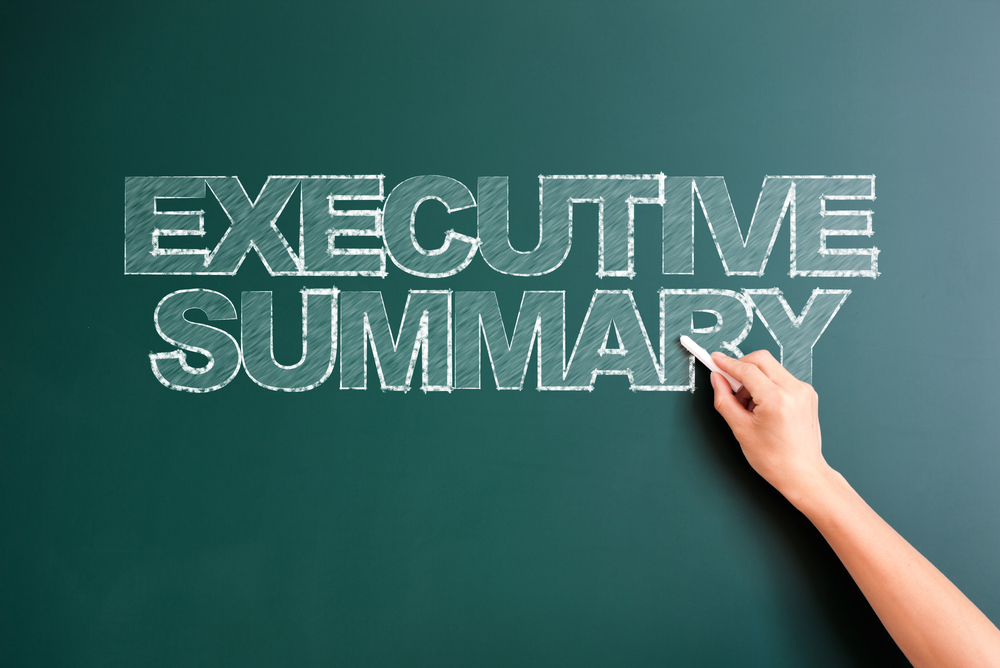The executive summary is a key tool to garner investor interest and support.
Your executive summary is the “hook” in your business plan that grabs attention and creates interest in your company. As one of the first things you send to prospective investors, it needs to be crisp and clear. Just like a resume is designed to get you and interview, and not a job, the exec summary is designed to get you a meeting, not a term sheet. The exec summary should clearly explain your target customer’s pain point, their unmet needs, your solution and its unique value proposition, why you have a sustainable competitive advantage, and the progress of your company to-date.
Follow a Prescribed Framework and Structure
Include key information and present it in an order that is familiar to investors. Keep the summary to one page, make it graphical where possible, and use sidebars to give key information that isn’t part of the narrative. Make the content scanable and easy to follow. The key elements of an exec summary are:
Mission Statement: A description of your idea in the context of the problem that you are solving for customers. It tells what your business is all about, and is typically several sentences to a paragraph.
Brief Product Description: Information about what your product does for the target customer. You do not need tons of details about how the product works. Emphasize your intellectual property position and how it is sustainable. Focus on the product features, benefits and value.
Company Information: Founding date, names and roles of the founders, the key employees, the number of employees and business locations.
Growth Highlights: Include things like monthly or quarterly revenue growth, gross margin expansion, and operating leverage. If you are pre-revenue and pre-product, there is still an opportunity to talk about growth in terms of your target market.
Financial Summary: Key financial information should be presented as graphs, figures, and infographics. Generally, the presentation should be visual where possible, and where it makes sense. If you have good graphics, it will make things a lot easier for investors to understand.
Summary of your Future Plans: What are the goals for the business? What are your key milestones? Where do you want to take your business over the next three years? Articulate your funding request and how you plan to use of the money raise.
Do Your Homework and Articulate the Facts
You should run a strategic planning process and prepare an annual operating plan and budget for your company. As a result of following this process, you will have a clearer understanding of your markets, your target customers and the problem that you are trying to solve for them. You will be able to describe your value proposition, customer acquisition cost (CAC), customer’s lifetime value (LTV), and sustainable competitive advantage. In other words, you will have all the source information you need to prepare a solid business plan for investors. Your exec summary is a high level summary of that very information.
Status of Execution and Progress
Timing is critical when it comes to entering a new market, building a product, and raising capital. Where the status of your product development intersects the market helps determine how much money you will be able to raise, and which types and stages of investors you should pursue. Articulate milestones and demonstrate progress. Raising money is a process, not an event. As such you will have multiple touch points with prospective investors over several months. You need to make progress on your key milestones during that timeframe, or you will not have credibility.
Investors Want the Numbers
Prospective investors are looking for you to clearly and articulately describe your business plan and business model – in other words, how you make money. To do this with credibility, you need to show market size and growth, and your financial history and goals. All of this information needs to be based on a set of assumptions that you can clearly and crisply articulate and defend with a highly skeptical and critical audience. Investors will be judging you individually, your credibility, and your track record – including any milestones that you have achieved to-date.
Highlight Your Team and Why You’re Different
Just like customers, investors need to know, like and trust you before they will do business with you. They have to believe in you. Does your team have the requisite expertise, experience and credentials to accomplish the mission? The more you communicate and then achieve critical milestones and deliver on results, the more credibility you will have with investors.
It is critically important that you know your audience. Be willing to tailor your executive summary to your audience, at least for the most important target investors. For example, if you are talking to a purely financial investor, you focus your message on that audience, and likewise with a technical specialist. Different investors may have a different basis of knowledge that they are operating from. Having an executive summary that keeps your target audience in mind will help it stand out among the hundreds of other summaries they may in a year.
This article originally appeared in Inc Magazine.
